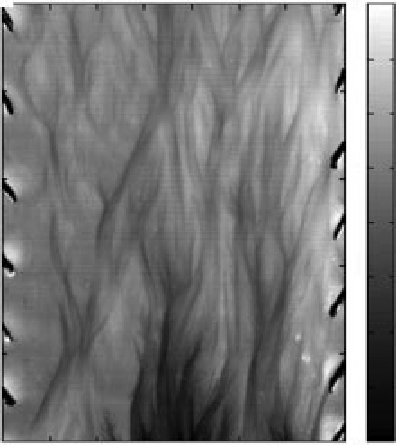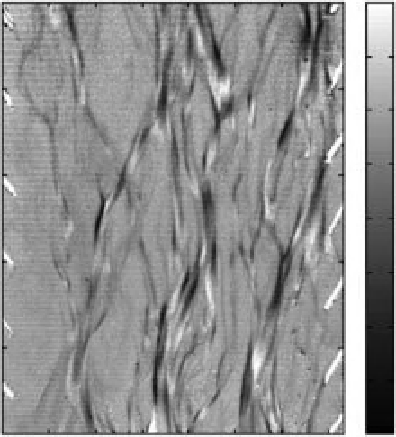Geography Reference
In-Depth Information
Dry topography
Water depth
4
1
3
0.5
200
200
2
0
1
−
0.5
400
400
0
−
1
600
600
−
1
−
1.5
−
2
−
2
800
800
−
3
−
2.5
−
3
1000
−
4
1000
200
400
600
200
400
Width (mm)
600
Width (mm)
(a)
(b)
Figure 13.20
Results of a moire projection method, (a) bed topography obtained with flow turned off, zero represents the original
flat reference bed (b) flow depths obtained by subtracting images with and without flow (Limare et al., 2011). Flow increases in the
negative direction. Zero represents dry bed. Positive flow depths represent noise that was later removed.
the experimental setup. The equipment required typically
involves at least one digital camera or video recorder and
computer to operate the camera remotely and download
photos automatically. The type of camera that should be
used depends on the method, e.g., basic digital camera for
acquiring timelapse images (multiple cameras or a wide-
angle can be used for large experiments), high-speed video
recorder for PTV, and CDD camera for a moir´emethod.
The latter also requires a video-projector. Cameras usu-
ally include software enabling control of only one camera
at a time per computer, however commercial software
is available for operating multiple cameras simultane-
ously from a single computer. Most of the difficult work
involved in imaging techniques in conjunction with lab-
oratory experiments is in the initial setup, assuming the
setup remains constant thereafter. Once all equipment is
placed in the optimum position (e.g., height and distance
of the camera and projector), the optimal conditions
have been established (e.g. lighting, dye concentration,
colour of the sediment), and all necessary calibrations
have been made (e.g., stitch points, image rectification),
data acquisition is relatively fast and simple with minimal
disruption to the experiment. While many image process-
ing techniques are based on complicated equations and
algorithms, user-friendly software are available to guide
users who do not wish to develop their own programs
from scratch. Equipped with such software, excellent
results can be achieved with only a basic understanding
of the technique and adequate trial and error. Likewise,
software is available to batch-process operations such as
image rectification, cropping, stitching, colour thresholds,
etc. for a large series of images.
Acknowledgements
We are grateful to Maarten Kleinhans and Richard Hardy
for reviewing this chapter and for providing helpful
comments.
References
Adrian, R.J. 2005. Twenty years of particle image velocimetry,
Exp Fluids
39: 159-169.
Ancey, C., Bigillon, F., Frey, P., Lanier, J., and Ducret, R. 2002.
Saltating motion of a bead in a rapid water stream.
Phys Rev
E
66 (3): 036306.
Ancey, C., Bigillon, F., Frey, P., and Ducret, R. 2003. Rolling
motion of a bead in a rapid water stream,
Phys Rev E
67 (1):
011303.







Search WWH ::

Custom Search